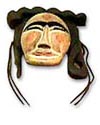Andong
January 22, 2006
Today was yet another wonderful day filled with
visiting traditional Korean places with Jin's family. I have
spent more time traveling and seeing places with them than I ever
did with my own family!
Today's trip took us to the area known as Andong.
It's billed as the Korean Capital of Spirit and Culture. First
we visited the Hahoe Mask Museum that not only has traditional
Korean masks, but masks from all around the world. There's
really no "ancient American" masks, so it was very interesting to
see this museum.
| Copied without permission
from
http://www.lifeinkorea.com |
  At the heart of the museum is the
collection of masks and costumes used for
Hahoe Pyeolshingut
T'alnori. A combination mask dance,
drama, and shaman rituals consisting of 9 different
acts, it has been performed every January from as
early as the 12th century. It makes fun of the
ruling class using humor and satire, and tries to
ease tensions among the different social classes. In
addition, the shaman rituals performed pray for a
prosperous year and are supposed to prevent natural
disasters.
At the heart of the museum is the
collection of masks and costumes used for
Hahoe Pyeolshingut
T'alnori. A combination mask dance,
drama, and shaman rituals consisting of 9 different
acts, it has been performed every January from as
early as the 12th century. It makes fun of the
ruling class using humor and satire, and tries to
ease tensions among the different social classes. In
addition, the shaman rituals performed pray for a
prosperous year and are supposed to prevent natural
disasters.
In 1964, the government declared
Hahoe Pyeolshingut
T'alnori Important Intangible
Cultural Property #69. The costumes used are modest
compared to other ceremonial mask dances, and the
movements very natural. Although originally 12 in
number, only 9 masks are currently used.

Imae
Fool |

Bunae
Flirtateous Woman |

Chung
Fallen Monk |

Halmi
Widow |

Ch'oraengi
Scatter-brained
Meddler |

Baekcheong
Butcher |

Seonbi
Scholar |

Kaksi
Bride |

Yangban
Aristocrat |
|
|
|
After the museum we went to Hahoe (pronounced "ha-hwae")
Folk Village:
Hahoe's history dates back to the late
Koryo period (918-1392). Unlike other villages, both upper class
and commoners lived in the same village together, with the upper
class houses located in the village center and the lower class ones
along the outside. Another distinguishing feature is that the houses
face in all directions from the center. (Most houses in other
villages all face south.)
Yangjindang is one of the oldest houses in the village
that belonged to the head of the Ryu clan in the P'ungsan area. It
has been designated Treasure #306. Ryu, Seong-ryong (1542-1607), a
famous court minister who helped protect Korea from the Japanese
invasion of 1592, lived here. Across the river from Hahoe,
Puyongdae offers a picturesque setting with forested
cliffs overlooking the river.
I took a ton of pictures of the museum and the folk
village. It was an amazing treat to walk in a village that has
been kept in the traditional style. Just thinking about
walking on the same ground that ancient Koreans did over 5,000 years
ago was mind blowing.
Here's yet another big montage of
my day.
The last 6 or 7 pictures are some of my favorites.
I recommend left clicking on one (to make it larger), then right
click on the photo, and then left click "Set as Background."
Your desktop will then have a beautiful picture and that will be
pretty close to what I experienced today. Don't choose me
sweeping though. Your monitor might break!
What I learned
today about Korea: 1) Certain masks go with certain
dances. Each dance comes from a particular place in Korea and
that's where the training and performance of that dance takes place.

|
|
![]()


![]()









